Horsetail identification guide
What is Horsetail? Read through our Horsetail identification guide below. If you are still unsure, email us your photos and we will confirm whether it is Horsetail for FREE
Toxic to livestock and damaging to the infrastructure of buildings, roads and paths, the common Horsetail is a perennial plant that is difficult to control once it gets a foothold. It invades by dispersing spores and, more commonly, spreading underground through a network of fast-growing rhizomes
Quick facts
- Horsetail is a native fern-like perennial that does not flower, spreads mainly through a network of rhizomes underground.
- It has been estimated that horsetail has the potential to infest an area of 1 hectare within 6 years of introduction.
- Rhizomes can also grow as deep as 2m which makes them difficult to dig out and completely eradicate.
- Common Horsetail can often enter gardens from a neighbour’s property as the rhizomes spread underground and unseen.
Quick Links




What is Horsetail?
Field or common Horsetail, or Equisetum arvense to give it its Latin name, is an invasive herbaceous perennial plant. It’s also called snake grass and puzzle grass and is often mistaken for Marestail.
Horsetail is one of the longest surviving plants on our planet, its ancestors dating back some 350 million years. Since ancient times, it has also been used to treat various ailments and people still recommend it today for reducing fluid retention, and kidney and bladder problems. It is, however, poisonous to livestock, particularly horses if consumed in large enough quantities.
Common Horsetail plants quickly build into extensive clusters and take over local habitats if left uncontrolled. This particular variety of the species is widespread across Britain, often found on roadsides, in gardens, on paths, brownfield sites and wasteland. There are several other varieties of Horsetail plants, and they tend to be restricted to certain habitats. These include Marsh Horsetail and Water Horsetail.
What does Horsetail look like?
In general, Common Horsetail plants resemble small fir-like trees rather than conventional weeds. It’s a perennial so it dies off almost entirely in the winter months and lies dormant during the cold weather.
In spring, around March and April, Horsetail will start to emerge and the first thing it will do is produce spore-containing cones. These curious structures are about a centimetre long and are attached to fertile brown stems which grow from the ground, and have darker ridges, similar to Bamboo. These stems turn green in summer and can grow to a height of 50 to 60 cm over the summer after the spores have been released.
The spring growth comes from the rhizomes underground that have lain dormant over the winter. One Horsetail fertile stalk and cone can produce thousands and thousands of spores that are suddenly released into the air and get blown on the wind for miles. Of course, on quiet days they can simply float over into your neighbour’s garden.
Once the spores have been released, the original Horsetail reeds will continue to grow and should reach maturity around the end of April and into May. Beneath the surface, however, more is going on as the rhizomes continue to spread. Each Horsetail rhizome will either stay dormant or develop into shoots depending on the conditions.
As autumn approaches, the plant begins to die down again and will return to dormancy until the next spring when the cycle begins again.
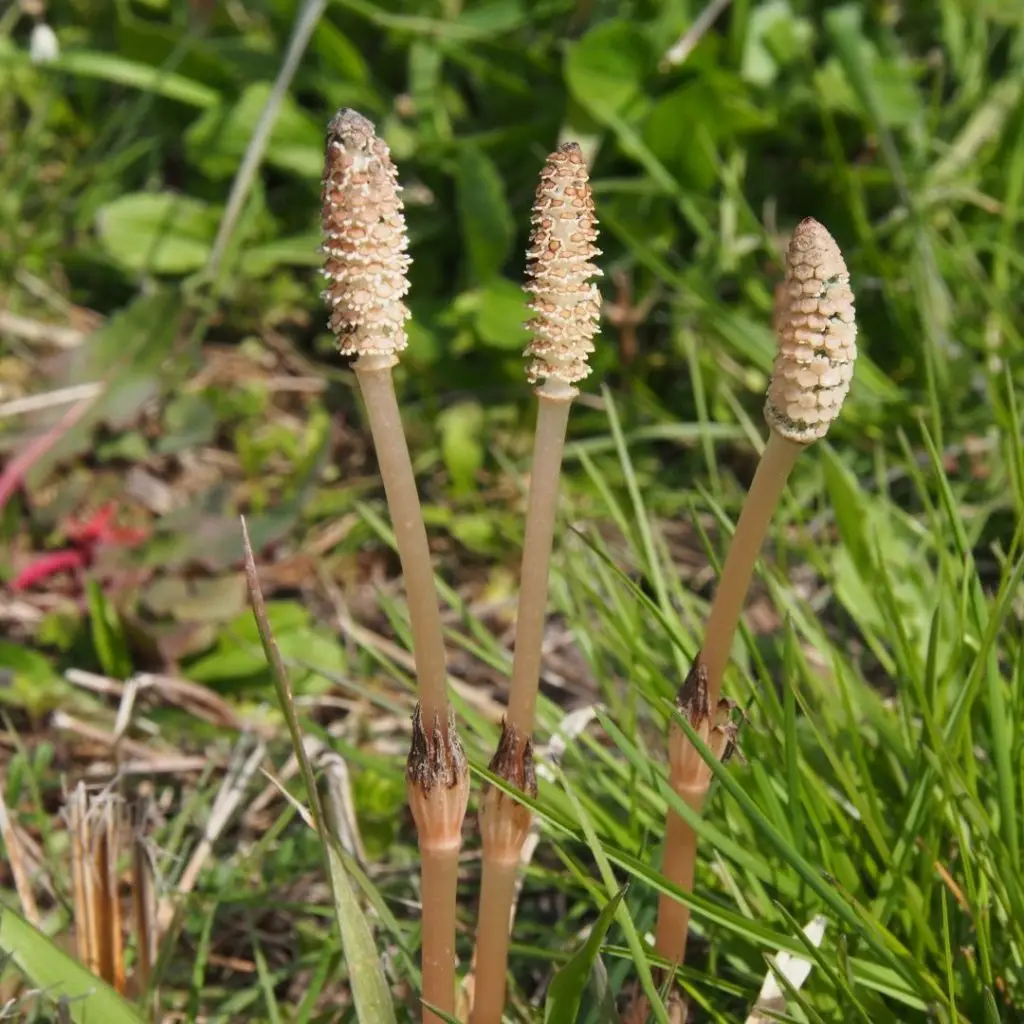
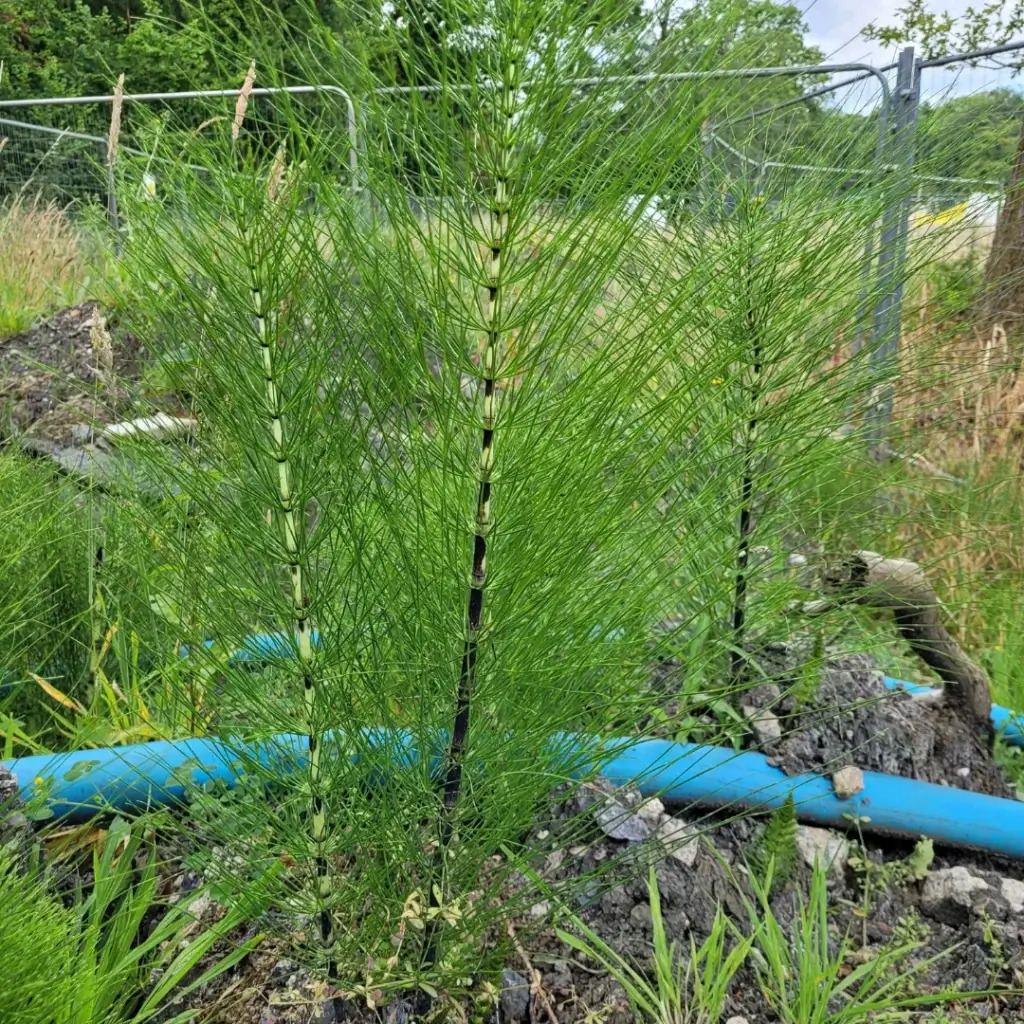
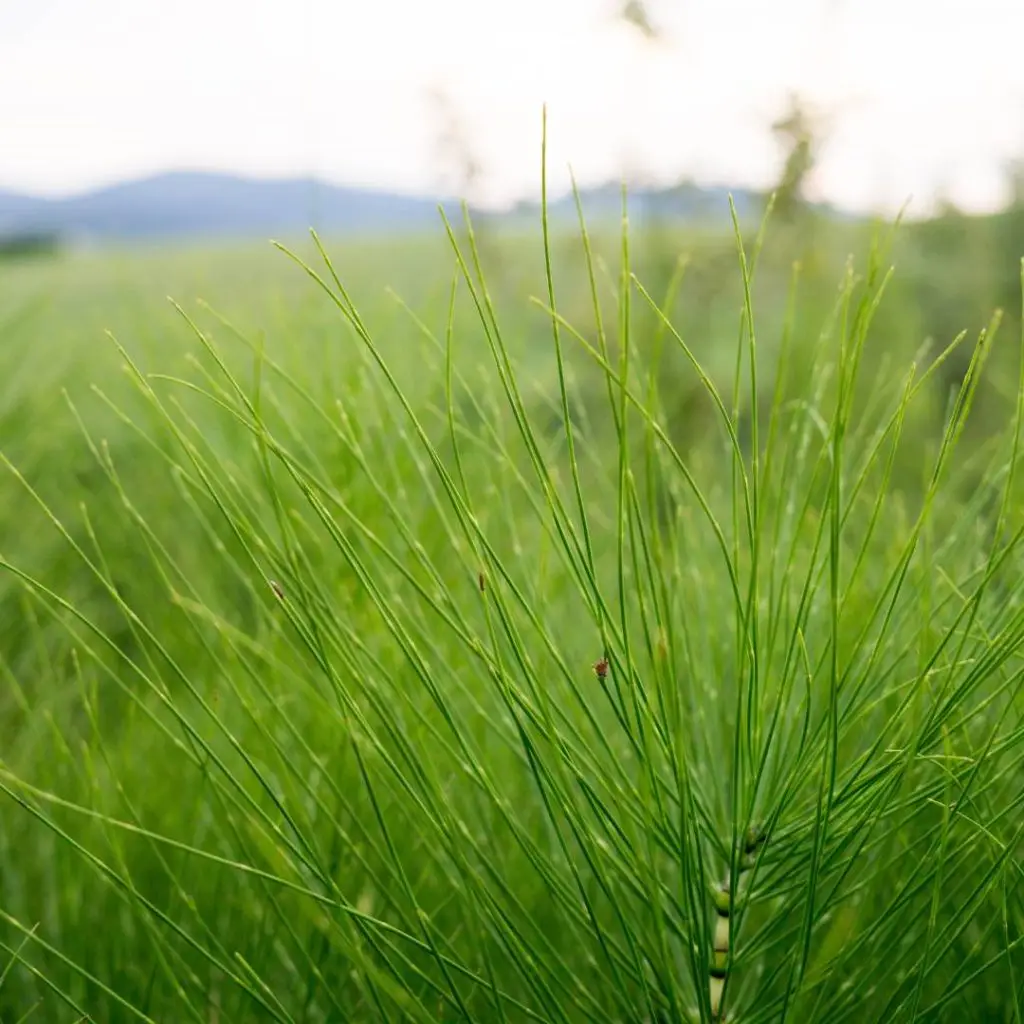
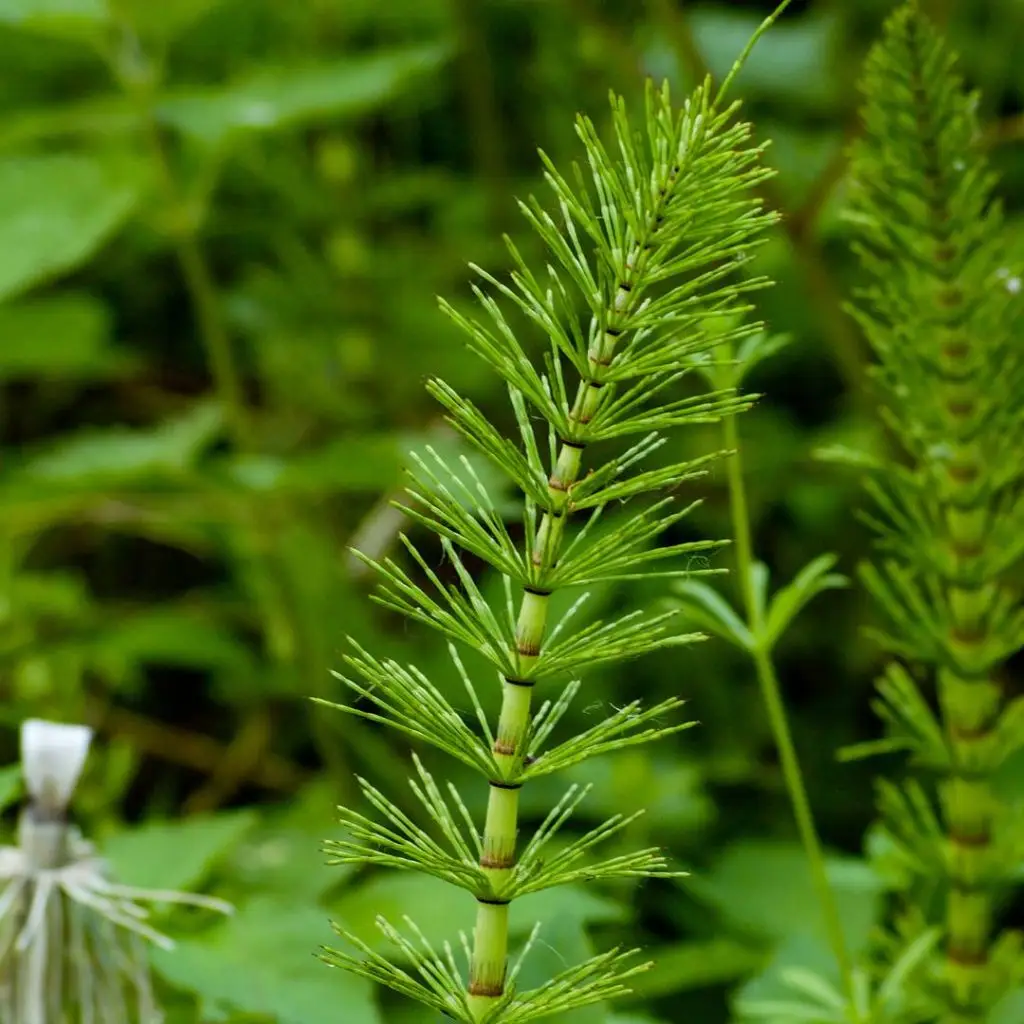
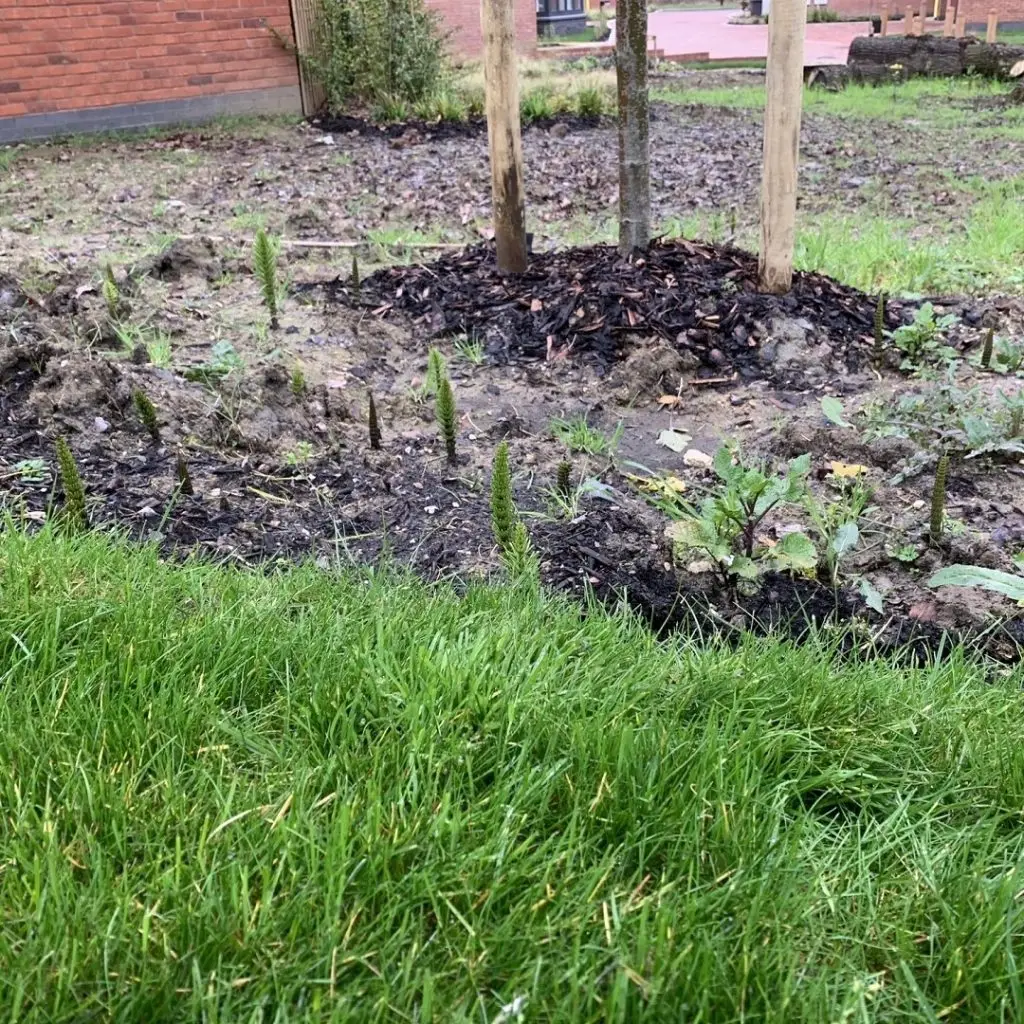

Horsetail roots
If you spot a plant like a Horsetail, you may be tempted to simply pull it up and throw it in the composting bin. The problem is that Horsetail roots are rhizomatic which means they send out offshoots of the stem into the soil. It’s why they are sometimes called creeping root stalks.
What’s happening under the ground with common Horsetail is just as important, perhaps more so, than what’s going on above the soil. The rhizomes begin to spread quite quickly under the right conditions and that doesn’t just mean horizontally out laterally, but also deep down into the ground.
If you remove the top part of the plant and leave the rhizome network in the soil, the Horsetail will continue to grow and cause problems.

Horsetail vs Marestail
Horsetail often gets called Marestail and vice versa but they are two different plants. Marestail or Mare’s Tail is native to Britain but has spread practically all over the world in the last several hundred years. Its official Latin name is Hippus vulgaris.
They are both weeds, but the Marestail is an aquatic plant. They are both invasive species and have a superficial resemblance with each other. It has similar jointed stems that branch out from the base, but the biggest most common difference is that Marestail flowers while the Horsetail does not. Furthermore, Marestail does not open out into fern-like fronds, remaining more cone-shaped in apprearance.
Marestail tends to be found beside ponds and riverbanks. When it grows in still water, it is erect, but it bends in rivers along with the current. The plant is highly susceptible to frost so tends to be more prevalent in the south and east of Britain.
Horsetail is more likely to turn up in your garden, on isolated waste ground or brownfield sites than Marestail because the latter needs plenty of water to thrive.
Horsetail varieties
There are several different varieties of Horsetail in Britain and the most widely seen are Common or Field Horsetail and Marsh Horsetail.
- Field Horsetail (Equisetum arvense): Field or Common Horsetail is the most prevalent of the varieties in the UK. The spore holding cones of these are is a green-brown colour about a centimetre in length.
- Marsh Horsetail (Equisetum palustre): As its name suggests, this Horsetail prefers damper conditions, and the spore cone tends to be spotted and quite distinct. It is most often found in marshes and wet meadows.
- Water Horsetail (Equisetum fluviatile): This too prefers marshes and wetter regions. It’s similar to the marsh Horsetail but the spore cone is slightly larger and it’s a lot harder to spot as it is much rarer than other varieties.
- Wood Horsetail (Equisetum sylvaticum): This tends to like deep, peaty soils so it’s not as widespread as other Horsetail varieties either. It’s the only variety that has additional vegetative branches that grow from the main branches.
- Great Horsetail (Equisetum telmateia): As the name suggest this is a larger version of the Horsetail and the spore cone can grow to about 8 cm and the stems up to 2 metres. It prefers marshes and wetlands rather than drier conditions.
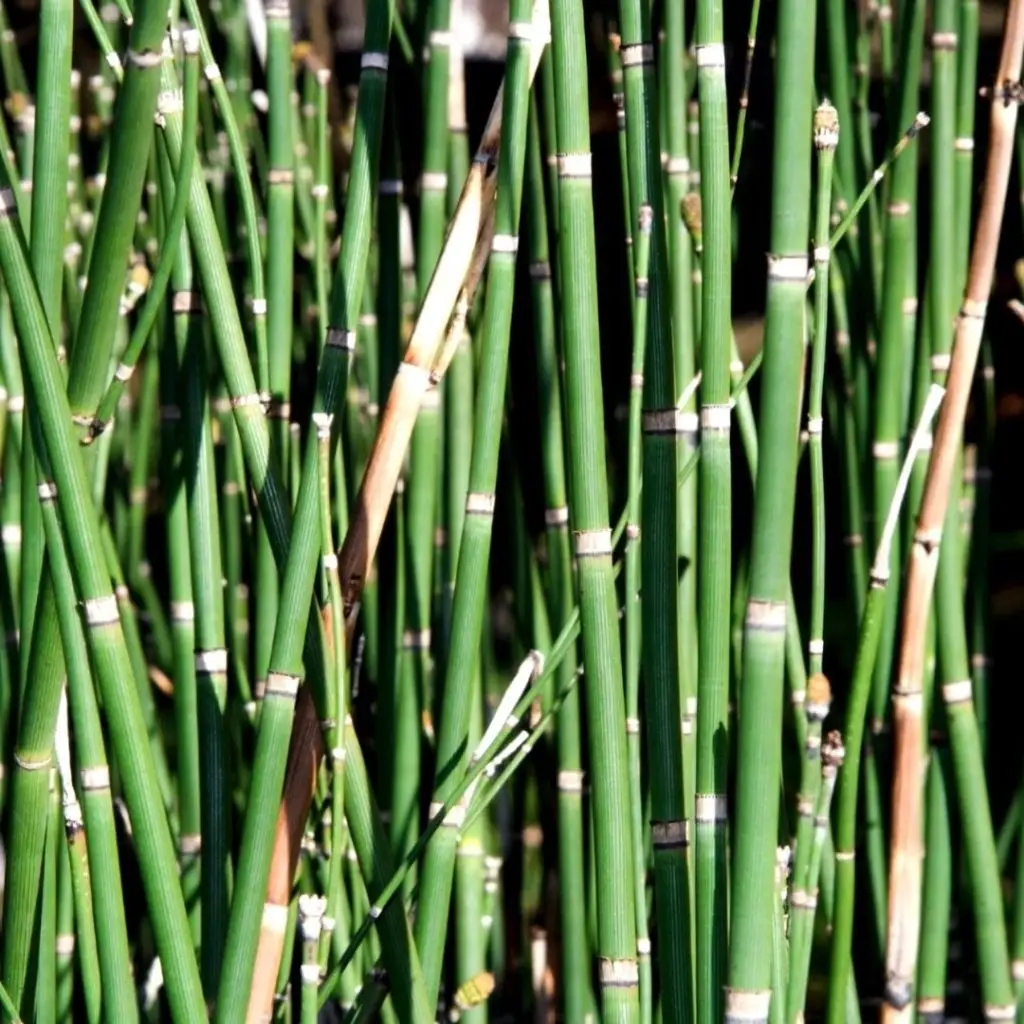
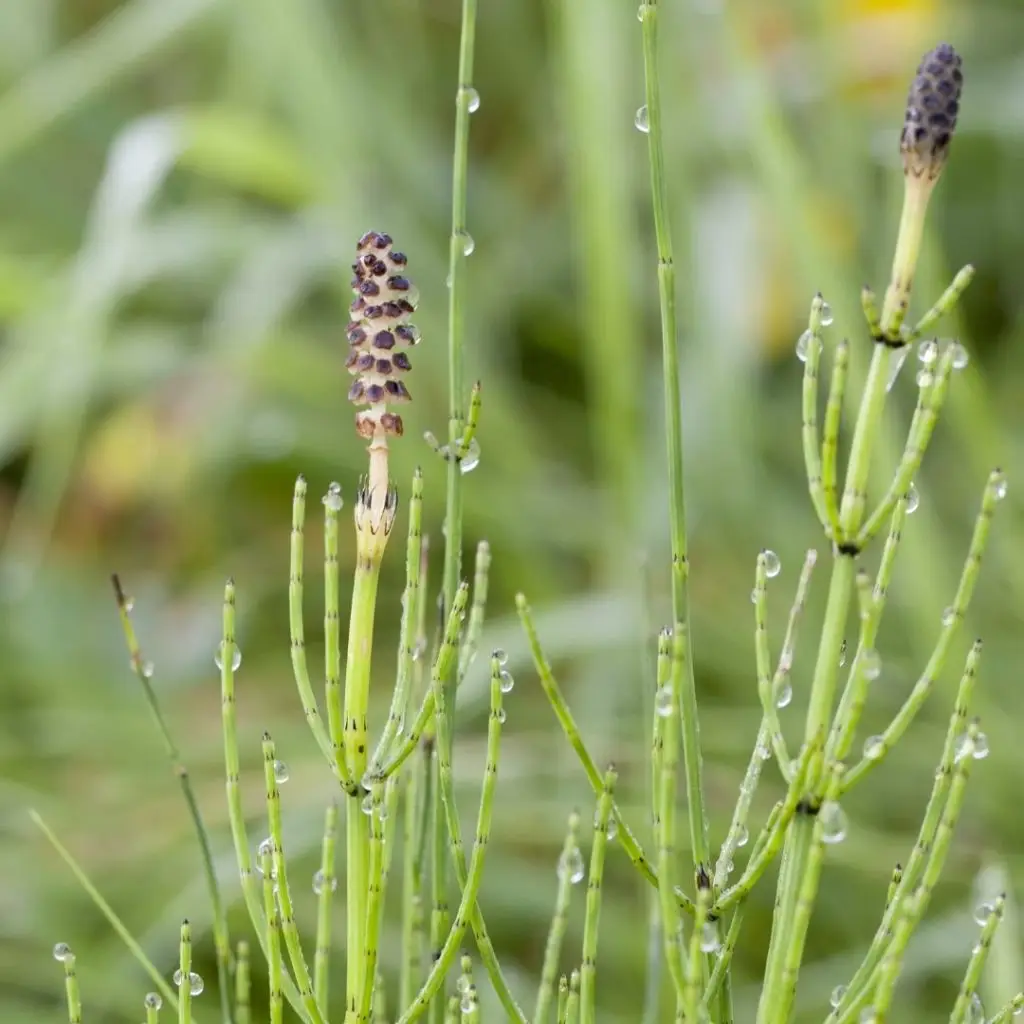
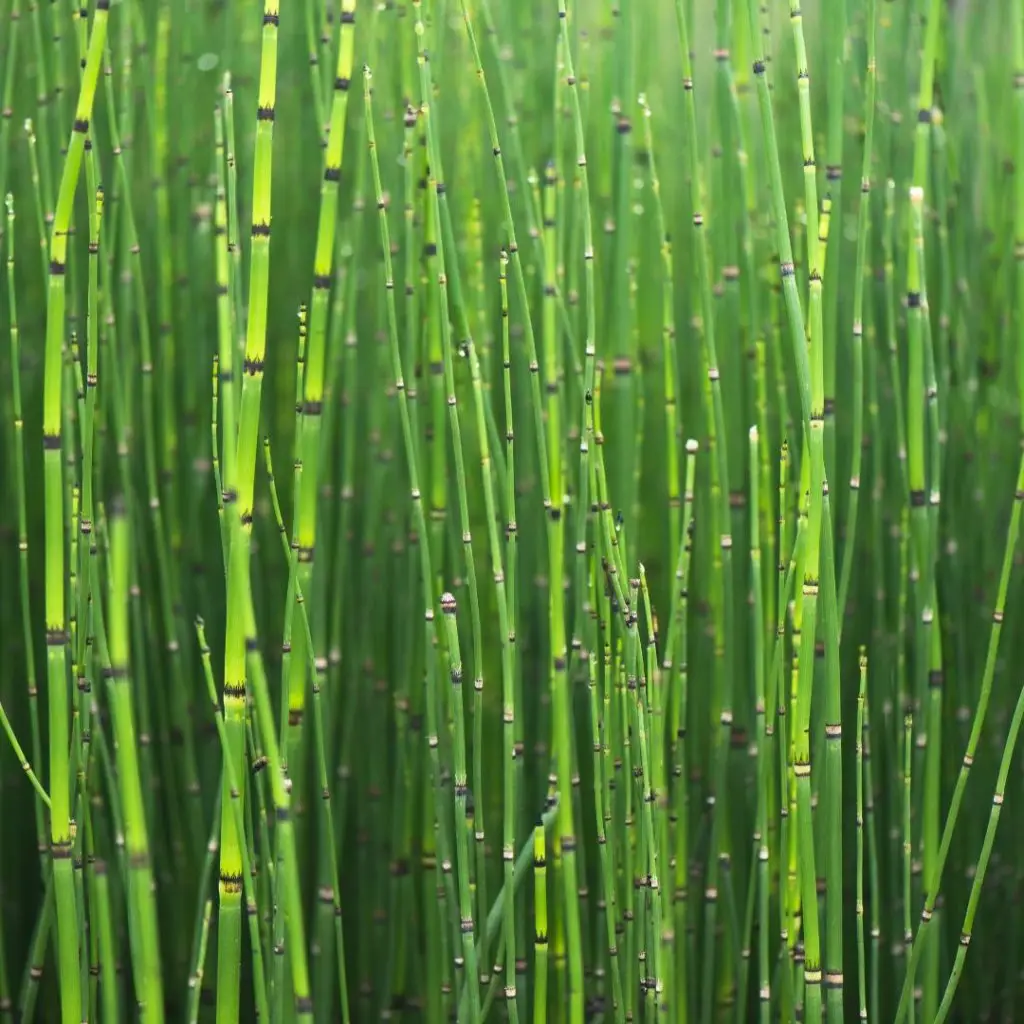
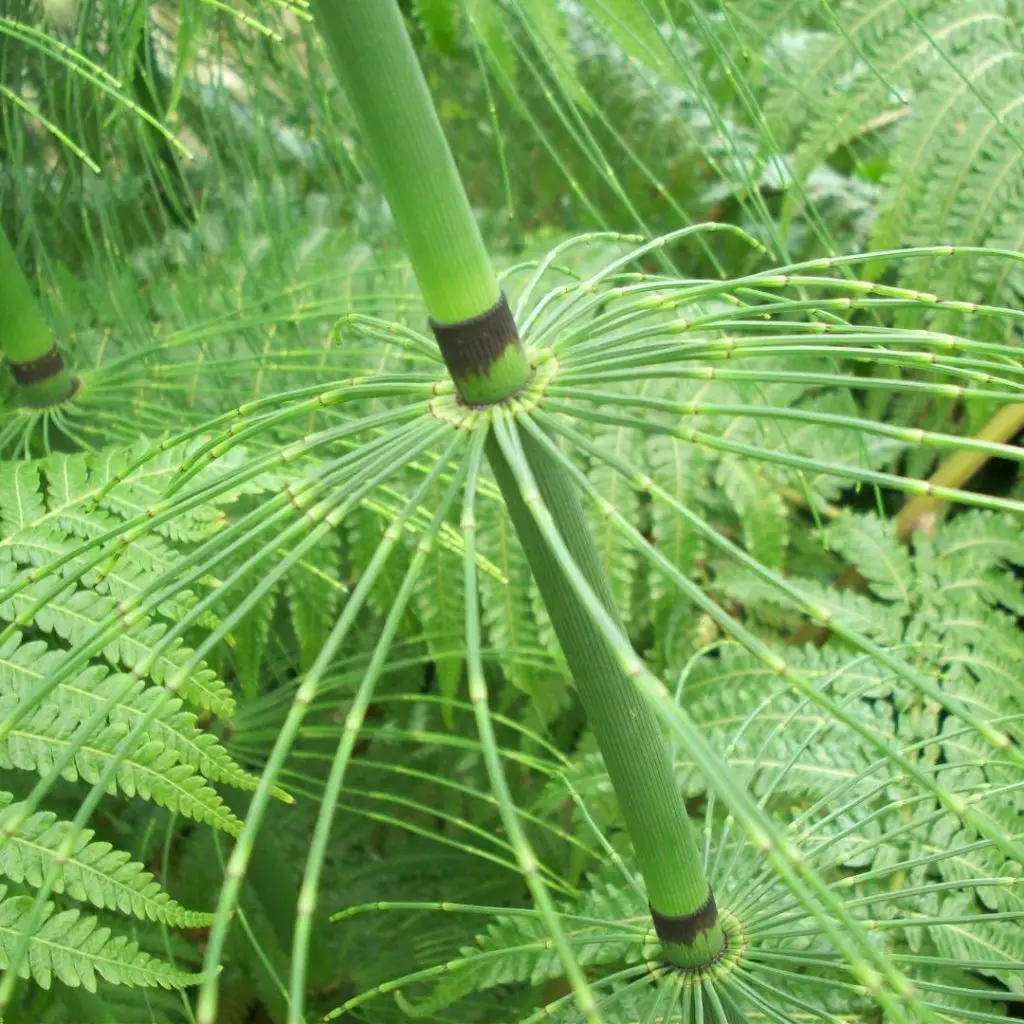

Why is Horsetail a problematic species?
Common Horsetail is the variety that causes the most harm to infrastructure, homes and businesses in towns and cities. There is nowhere in Britain that it isn’t found at least in some capacity.
One of the major problems with Horsetail, similar to Japanese knotweed, is the depth to which the rhizomes can grow. About 50% of the rhizomes are near the surface, less than 25 cm deep. In good soil that is moist and drains well, the rest can be anything up to 2 metres or about 7 feet down. This means that it is not easy to eradicate without excavation.
The issue here is that even a small part of a Horsetail plant rhizome can begin to regenerate and start creating a new infestation. The growing plants will use and expand already existing weaknesses and cracks in paving.
If Horsetail is found on a wasteland or a construction site, it can create a real headache. Work on the building or site will not be able to go forward until the infestation has been completely cleared away. Building new homes or offices on top of dormant rhizomes can be a recipe for disaster.
On the surface, Horsetail will quickly overpower existing ecosystems and change habitats putting some species in a particular area at risk. Because it can spread by both airborne spores and through growing rhizomes, it’s difficult to stop once it gets started. Especially in the countryside, Common and marsh Horsetail can be a significant challenge to local ecology.
Is Horsetail illegal?
Horsetail is not listed in Schedule 9 of the Wildlife and Countryside Act 1981 as an invasive species, as the legislation covers non-native invaders, but it is a cause for concern if you find it growing in your garden.
Some councils do have their own rules and regulations surrounding Common Horsetail and encourage residents and businesses to contact them if they see any growth or incidence of the plant. This is because damage caused by the plant to infrastructures such as streets, roads and pavements can be very costly to repair.
Whether you are a homeowner or business, if you find Horsetail on your property, it makes sense to do something about it sooner rather than later. It is difficult to manage Common Horsetail with traditional gardening approaches, especially if the rhizomes are well-established and quite deep. If you’ve ever tried digging a hole a foot deep, you’ll know how much work it can be with just a spade.
Even using the above tactics, you may not be sure that all the rhizomes have been removed as they can be up to 2m deep. Another option is to use herbicide, which can take several years of repeat application before you see results and is often not guaranteed. It is always worth discussing your problem with an invasive species specialist who may be able to offer some professional advice, or implement a proper plan for you.

What our clients say
Reviews
Ali Hamaad
“I used Environet following a recommendation to help with invasive Japanese Knotweed in my garden. Very professional, responsive and managed to co-ordinate with other contractors working on my property to remove the knotweed.”
Bernadette Spencer
“Richard was able to book us an assessment visit very quickly regarding the encroachment of evasive running bamboo in our garden .. Will completed the assessment visit,we found him to be very professional, but also friendly and easy to talk to. “
Phil Smith
“This is a very professional operation; always just on the end of the phone. The whole team seemed to know exactly what was going on with the job. (and my neighbours were very happy too.)”
Kim
“I’d just like to take the time to commend the team I have spoken to already, in particular Rachel and Suzie – they have been so friendly, reassuring and informative which has really eased the stress around this situation. Thank you all for your time. .”
L Schjolden
“I would like to commend your man Ed, who was in charge of the works at our property. He was a pleasure to deal with — punctual, polite, professional, responsible. He always kept me up to date with the progress of the works and made sure there was as little disruption to our lives as possible.”
Start fixing your invasive plant problem today by requesting a survey
Request a survey
Rest assured, where invasive species are identified at an early stage and tackled correctly, problems can usually be avoided. Our specialist consultants complete thorough surveys to identify the extent of the problem. Our plans aren’t one-size-fits-all; they’re customised to tackle the invasive species at your property effectively, taking account of all of your requirements.
GET IN TOUCH
Contact us
Our team of experts is available between 9am and 5:30pm, Monday to Friday to answer your enquiries and advise you on the next steps
Want a survey?
If you already know you have an invasive plant problem, you can request a survey online in less than two minutes by providing a few brief details. A member of the team will swiftly come back to you with further information and our availability.
Need quick plant identification?
Simply upload a few images of your problem plant to our identification form and one of our invasive plant experts will take a look and let you know, free of charge what you are dealing with. We’ll also be there to help with next steps where necessary.



